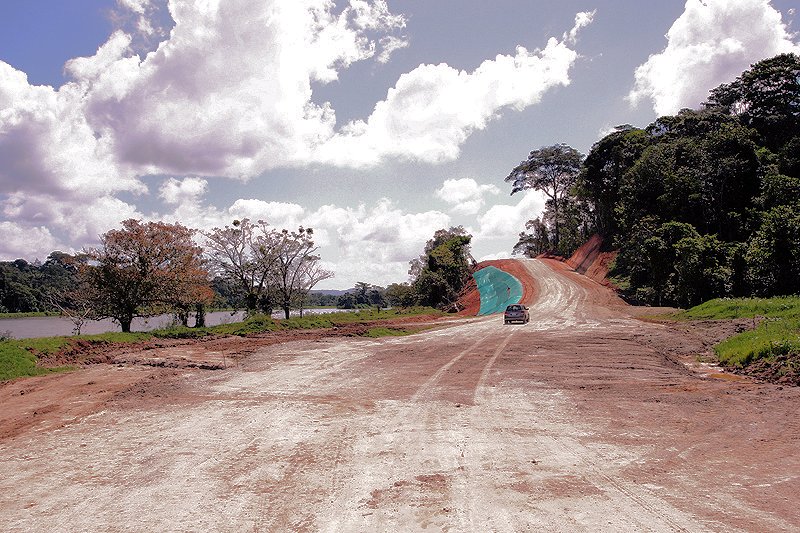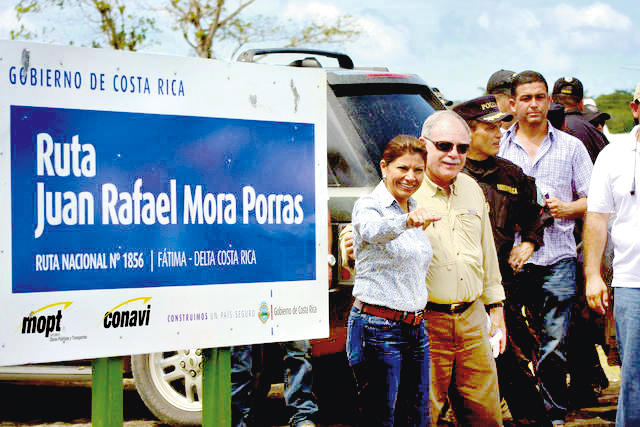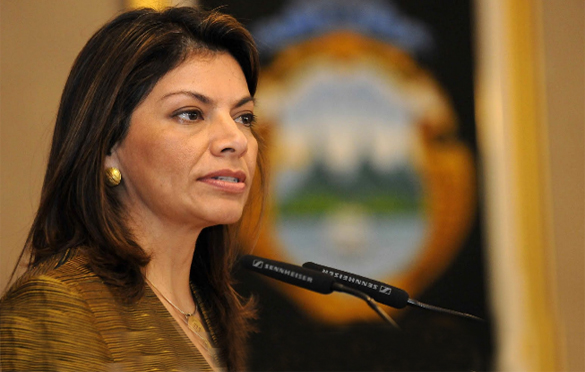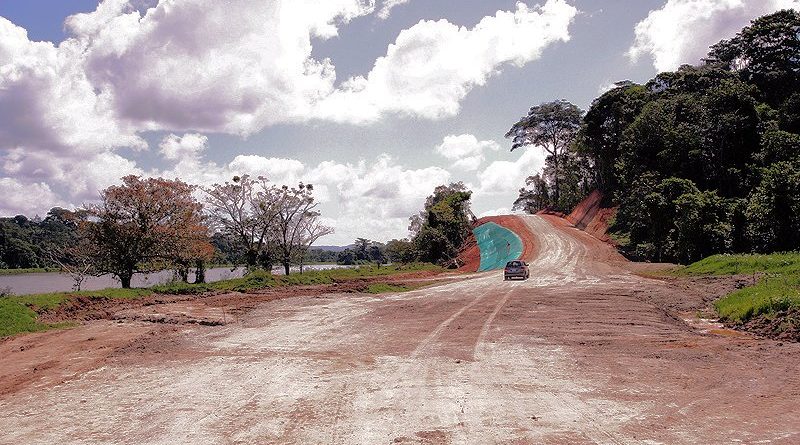Fallout From Reactionary Costa Rican Road Construction Project The Latest In Chinchilla Corruption Allegations
The fallout from a 2010 incident over a historical territory in dispute between Nicaragua and Costa Rica continues to be a compass of relations between the administrations of Costa Rican president Laura Chinchilla and Nicaragua’s Daniel Ortega. The dispute is heavy on nationalistic sentiment but littered with corruption and administrational malfeasance. The latest development comes as Chinchilla presently faces a hearing on her contracting the construction of a large, costly transportation route known as Ruta 1856, straddling a sizable swath of the Nicaraguan border. As a result, los ticos (as Costa Ricans are commonly known) have good reason to question their government’s commitment to transparency and accountability, which inherently suggests it has none. Indeed, Chinchilla’s term continues a long line of Costa Rican presidencies ending in indictment.[[i]]

In October of 2010, when Nicaragua began dredging the Río San Juan’s sediment deposits on the Isla Calero’s river delta, it hardly registered even as a blip on the international radar until Nicaraguan workers began felling trees and dumping residue on the island at the mouth of the Caribbean Sea. As Nicaraguan soldiers entered the territory claimed by Costa Rica, an alarmed San José interpreted the act as an “invasion” and cited evidence of such crimes as well as environmental concerns over the river’s diversion into their neighbor’s territory.[[ii]] Nicaragua’s response was the bizarrely infamous “Google Maps” defense submitted to the Organization of American States (OAS) in explanation of its presence on the disputed territory.[[iii]] At the time, Google’s boundaries mistakenly placed the delta above the Costa Rican demarcation line, thus violating the definitive 1858 Cañas-Jerez Treaty of Limits and the subsequent cartographical clarification of 1897.
While the two countries historically have disputed the 1897 clarification, in March of 2011 the International Court of Justice reaffirmed the stipulations of the Cañas-Jerez Treaty. The decision maintained Nicaragua’s sovereignty over the San Juan River but stressed the expedited removal of troops from the disputed territory.[[iv]] Ortega and Chinchilla interpreted this decision as a victory for their respective countries, thus initiating a new round of renunciations from both sides.
Even though Managua’s “Google Maps defense” failed to hold up in The Hague, it attracted the attention of the international press and subsequently galvanized nationalistic sentiments in both Costa Rica and Nicaragua. Although both countries have capitalized on their patriotic claims, Chinchilla’s thinly veiled, but provocative public work projects forged by the border tension continues to roil the front along the San Juan River. Nevertheless, not a shot has been fired in this border confrontation as of yet, but the project functions less as a public necessity than as a diplomatic response to the president’s Nicaraguan neighbors. The project further constitutes the most glaring example in a trend of public corruption and wasteful spending under Chinchilla’s administration.
Mere weeks after the border flare-up, President Chinchilla revealed plans to build a 120-kilometer stretch of road alongside its stretch of the San Juan River, thanks to an “emergency decree” ¢7 billion colones (roughly $14 million USD) investment from the State-owned National Transportation Authority (Conavi) and funds from the National Commission of Risk Prevention and Emergency Attention (CNE). [[v]] Through such a portrayal, the government was able to legally circumvent environmental reviews and claims that such a road is necessary for the security of isolated residents of small river communities that have faced the possibility of being cut off from the rest of the country. [[vi]] With Costa Rica turning its attention once again to the sensitive border region, Ortega unsurprisingly denounced the project under “environmental” concerns, sending a notice to the Costa Rican foreign minister demanding its immediate cessation. [[vii]]

Yet, Costa Rica is not the only provocateur in the conflict, casting doubt on the prospects for a solution anytime soon. Ortega recently announced his plan to build a transoceanic canal á la the model in Panama, generating the predictable waves of Costa Rican indignation and ruffled Nicaraguan nationalism in the process. [[viii]]
Although the promotion of expensive domestic public programs might seem a counterintuitive means to project one’s international influence, the disbandment of Costa Rica’s army over 60 years ago left Chinchilla with a limited number of ways to rouse public sentiment. Indeed, in the inauguration of the first stretch of the road in February of this year, San José chose to name it after former Costa Rican president Juan Porras, best known for holding off a northern invasion in the middle of the 19th century. Thus, it did not take long for ticos to connect the bridge’s namesake to the Nicaraguan conflict, as government officials staged grandiose displays of political theater at different phases of the road’s completion.[[ix]]
As word leaked of Chinchilla’s new project, Nicaragua understandably raised eyebrows on its timing.[[x]] Indeed, this sentiment correlated with a damaging exposé that appeared last May in the Costa Rican daily La Nación.[[xi]] The article revealed that Conavi constructed the hastily built road without sufficient structural planning, including the lack of sufficient ditches, bridge reinforcements, or adequate curves for two-way traffic—unfathomably risky for a country that receives rainfall almost daily and is prone to earthquakes, flooding, and frequent volcanic activity. Beyond the road’s structural flaws, Costa Rica’s National Laboratory of Materials and Structural Models at the University of Costa Rica calculated that more than $40 million USD has been invested in the project, a figure that almost certainly will increase, given the disrepair and fortification requirements from which the road suffers.[[xii]]
A Term Marked by Scandal and Corruption
If one is to believe all of Chinchilla’s statements on attracting foreign investment, then it is impossible to ignore her active courtship of China, which is meant to improve her country’s infrastructure in order to absorb the subsequent influx of capital. Yet this is a goal that her administration seems thoroughly overwhelmed in handling. Allocation of funds for the Ministry of Public Projects and Transportation (MOPT), in which Ruta 1856 falls, were close to the equivalent of $500 million USD in Costa Rica’s fiscal year 2011. This figure puts the Transportation Ministry as one of the highest cost expenditures detailed in the country’s budget.[[xiii]] Yet, many are wondering how the waste, circumvention, secrecy, and graft in the Transportation Ministry can only signify an isolated incident. This sentiment bodes poorly for San José, which relies heavily on an international community that could regard anything suspicious of nature in its public sector as further manifest of ineptitude. In particular, China—already under fire internationally for its own deplorable human rights record—might reevaluate its recent practice of constructing free national projects for San José when Chinchilla’s practices have provoked such domestic strife.
Chinchilla herself has become entangled in investigations. Costa Rican media organizations report that the president will be forced to testify in front of the Legislative Commission of Control and Public Spending regarding her questionable role in commissioning Ruta 1856. On cue, photos from early August show much of the road in a state of inaccessibility, giving justification to The Hague’s recent condemnation of the project as one of “high risk and environmental danger.”[[xiv]] The inopportune resignation of Chinchilla’s minister of Public Works and Transportation, Francisco Jiménez, has compounded the problem with his revelation that many of Chinchilla’s own friends sat on the small commission in charge of the project. While problematic in itself, some members even lacked proper engineering credentials, provoking charges of incompetency and nepotism from the president’s critics.[[xv]]
Yet, the problems associated with the border road are hardly the sole cause célèbre of the public’s mounting distrust in the Chinchilla administration. In 2012 alone, Chinchilla’s Tax Administrator, a vocal critic of tax evasion, resigned after an investigation revealed he failed to pay taxes in 2008. Meanwhile, San José’s Finance Minister, Fernando Herrero, turned in his resignation when it was revealed he had skirted tax obligations as well. Furthermore, RECOPE, the State-owned oil refinery, granted a public relations contract to a company founded by Herrero. Besides the conflict of interest with Herrero’s being in position to profit from the arrangement, Chinchilla admitted under mounting public pressure that her brother was also involved in the contract.[[xvi]] As if that were not enough, some Costa Rican citizens have filed a lawsuit against Chinchilla for expediting projects for a Spanish company.[[xvii]]

As a result of these scandals, Chinchilla’s approval ratings have plummeted within the last two years, and her presidency has received the lowest evaluation of any Western Hemisphere leader in an April poll by a Mexican polling firm.[[xviii]] Moreover, only 31 percent of ticos believe that her administration has achieved positive results, causing one economist to lament that, as a result of these scandals, “she doesn’t have leadership, and the government suffers from a lack of direction.”[[xix]]
For her part, Chinchilla has remained a proponent of select national interests, including increasing power from renewable energy. She also remains a stalwart supporter of educational financing, as demonstrated by her call for an increase in governmental appropriations to that sector in 2010.[[xx]] But if the border conflict with Nicaragua is any indication, Chinchilla has succeeded only in exposing scandal, corruption, and resignations from a project that hardly adheres to the World Court’s recommendation of détente along the San Juan. In addition, Nicaraguans are gleefully following the unraveling of developments of the Costa Rican scandal—an ironic twist brought in by a project originally intended to confront them.[[xxi]]
Facing looming problems like a lagging economy, widespread tax evasion, the expansion of illicit drug trade, and poverty, to name but a few, both San José and Managua should have higher priorities than wasting public funds over a far-flung piece of environmentally sensitive territory. Costa Rica, with its abundance of natural resources, holds an additional incentive to establish itself as a worthy trade partner. Recently, China has looked to the country to establish a foothold in the numerous Free Trade Agreements to which it is affiliated, and San José cannot afford another monumental collapse in its public sector source for development funds. For Chinchilla, it may have been possible to pass off the San Juan River road under the all-too-familiar mantle of ardent nationalism, but such a strategy could hurt Costa Ricans, who continue to suffer under the ubiquitous presence of corruption and incompetence that characterizes their officials. Some two years from when her party will stand for presidential elections, Chinchilla desperately needs to operate with greater transparency to repair and reverse the great distrust stemming from what many Costa Ricans dismiss as a project of national embarrassment.
Trent Boultinghouse, Research Associate at Council on Hemispheric Affairs.
Originally published on August 31, 2012
Please accept this article as a free contribution from COHA, but if re-posting, please afford authorial and institutional attribution. Exclusive rights can be negotiated.
[i] Alvez, Emily and Johnson, Michael. “Paradise Lost: Costa Rica Falls Victim to Corruption and Clientelism.” Council on Hemispheric Affairs. December 8, 2004. https://coha.org/paradise-lost-costa-rica-falls-victim-to-corruption-and-clientelism/
[ii] COHA traced the conflict in Reed, Alexandra and Pear, Nicky. “Dredging Up an Old Issue: An analysis of the Long-Standing Dispute between Costa Rica and Nicaragua over the San Juan River.” Council on Hemispheric Affairs. Janurary 24, 2011. https://coha.org/dredging-up-an-old-issue-an-analysis-of-the-long-standing-dispute-between-costa-rica-and-nicaragua-over-the-san-juan-river-2/
[iii] Jacobs, Frank. “The First Google Maps War.” New York Times, February 28, 2012. http://opinionator.blogs.nytimes.com/2012/02/28/the-first-google-maps-war/.
[iv] “Reports of International Arbitral Awards.” United Nations, September 30, 1897. Volume XXVIII, pp. 215-222. http://untreaty.un.org/cod/riaa/cases/vol_XXVIII/215-222.pdf , and “A timeline of the Isla Calero dispute.” The Tico Times, Wednesday, March 9, 2011. http://www.ticotimes.net/Current-Edition/News-Briefs/A-timeline-of-the-Isla-Calero-dispute_Wednesday-March-09-2011.
[v] “Gobierno construye carretera de 120 km paralela al río San Juan.” La Nación, October 17, 2011. http://www.nacion.com/2011-10-17/ElPais/gobierno-construye-carretera-de-120-km-paralela-al-rio-san-juan.aspx.
[vi] Nicaragua Costa Rica Border Road Investigation Deepens.” The Costa Rican News, July 1, 2012. http://thecostaricanews.com/nicaragua-costa-rica-border-road-investigation-deepens/12582.
[vii] “Nicaragua envía nota de protesta a Costa Rica por construcción de carretera.” La Prensa, November 29, 2011. http://www.laprensa.com.ni/2011/11/29/ambito/82293.
[viii] Murillo, Álvaro. “País en alarte ante canal interoceánico en Nicaragua.” La Nación, July 4, 2012. http://www.nacion.com/2012-07-04/ElPais/Pais-en-alerta-ante-canal-interoceanico-en-Nicaragua.aspx.
[ix] Valladares, Sixto. “Chinchilla inaugural controversial vía.” El Nuevo Diario, February 18, 2012. http://www.elnuevodiario.com.ni/nacionales/242194.
[x] Bravo, Josué. “Ticos juegan al ‘yo no fui.’” La Prensa, August 16, 2012. http://www.laprensa.com.ni/2012/08/16/ambito/112629-ticos-juegan-al-no.
[xi] Oviedo, Esteban. “Conavi construyó la trocha fronteriza sin un solo plano.” La Nación, May 23, 2012. http://www.nacion.com/2012-05-23/ElPais/Conavi-construyo-la-trocha-fronteriza-sin-un-solo-plano.aspx
[xii] “Camino de la discordia.” Prensa Libre, August 5, 2012. http://www.prensalibre.com/internacional/CAMINO_0_749925038.html.
[xiii] “Costa Rica’s Federal Budget Dissected.” The Tico Times blog. September 7, 2010. http://theticotimes.wordpress.com/2010/09/07/costa-rica’s-federal-budget-dissected/.
[xiv] “Camino de la discordia.” Prensa Libre. August 5, 2012. http://www.prensalibre.com/internacional/CAMINO_0_749925038.html.
[xv] Aguero, Mercedes. “Chinchilla califica de ‘falsas’ declaraciones de exministro.” La Nación. August 16, 2012. http://www.nacion.com/2012-08-16/ElPais/chinchilla-califica-de–falsas–declaraciones-de-exministro-1.aspx.
[xvi] Levin, Matt. “What Else Can Go Wrong for Laura Chinchilla’s Government?” The Tico Times, April 13, 2012. http://www.ticotimes.net/Current-Edition/Top-Story/News/What-else-can-go-wrong-for-Laura-Chinchilla-s-government-_Friday-April-13-2012.
[xvii] “Costa Rica Government Believes that Lawsuit Against President Laura Chinchilla Will Be Dismissed.” The Costa Rican News, August 12, 2012. http://thecostaricanews.com/costa-rica-government-believes-that-lawsuit-against-president-laura-chinchilla-will-be-dismissed/13041.
[xviii] Córdoba, Cristian Leandro. “Laura Chinchilla La Peor Calificada del Continente.” La Prensa Libre, April 21, 2012. http://www.prensalibre.cr/pl/nacional/62317-laura-chinchilla-la-peor-calificada-del-continente.html.
[xix] Morales, Eugenia Soto. “Dos años de gobierno: Laura Chinchilla no levanta cabeza.” El Financiero, May 13, 2012. http://www.elfinancierocr.com/ef_archivo/2012/mayo/13/enportada3160097.html.
[xx] Morales, Eugenia Soto. “Dos años de gobierno: Laura Chinchilla no levanta cabeza.” El Financiero, May 13, 2012. http://www.elfinancierocr.com/ef_archivo/2012/mayo/13/enportada3160097.html.
[xxi] Bravo, Josué. “Corrupción ‘adorna’ carretera de ticos.” La Prensa, May 6, 2012. http://www.laprensa.com.ni/2012/05/06/ambito/100467.


